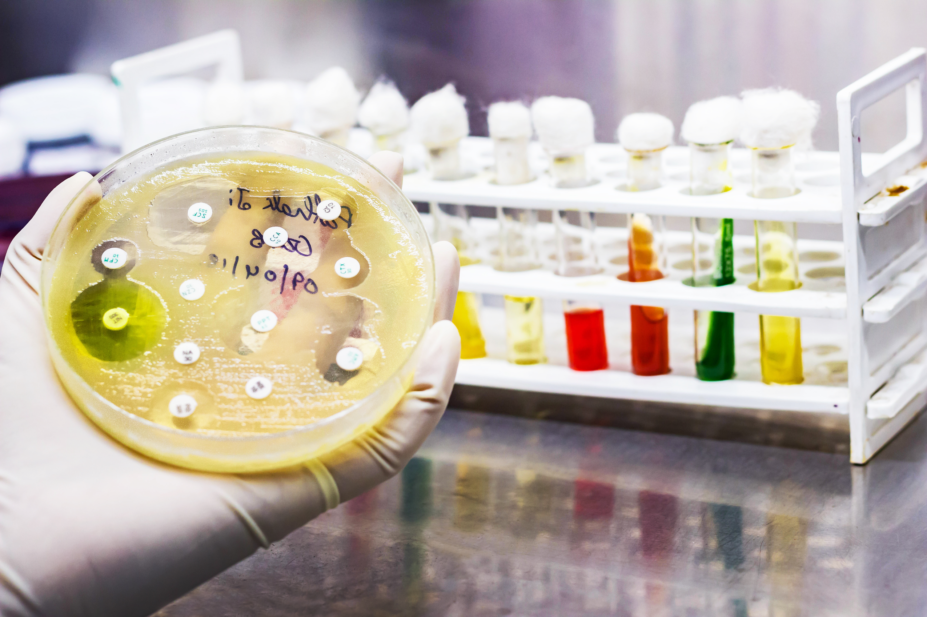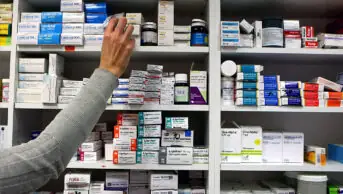
Alamy Stock Photo / JL
Although it remains a perpetual pilot, the NHS Urgent Medicine Supply Advanced Service (NUMSAS) is undergoing a surge in popularity with patients.
The NUMSAS, which sees patients referred to community pharmacy from NHS 111 for the urgent supply of medicines that they have previously been prescribed on the NHS, was first launched in December 2016 using money from the Pharmacy Integration Fund. In the first month, NHS England data showed that 658 referrals were made through the service.
Data from NHS England now show a 170% increase in referrals, with nearly 113,000 more patients signposted to NUMSAS between its first and second year, with 178,905 referrals made between February 2018 and February 2019 (see Table 1). However, with this increase in referrals, community pharmacy is fielding a larger number of requests for antibiotics.
According to data obtained by The Pharmaceutical Journal through a Freedom of Information request, the number of patients requesting antibiotics via the NUMSAS increased from 1,402 between March 2017 and February 2018 to 2,711 between March 2018 and February 2019.
This led to the number of courses of antibiotics that were supplied through NUMSAS in that time almost doubling, from 957 courses of antibiotics dispensed between March 2017 and February 2018 to 1,797 courses of antibiotics dispensed between March 2018 and February 2019.
These data show that amoxicillin and penicillin V were supplied the most over both years, followed by trimethoprim in 2017/2018 and doxycycline in 2018/2019.
This growing number of antibiotics being supplied through NUMSAS has raised a red flag with NHS England. In August 2018, it wrote to all NUMSAS providers setting out antibiotic dispensing data for the year between June 2017 and May 2018, which showed that 67% of all requests for antibiotics through NUMSAS were approved and subsequently supplied during that period.
Following its own analysis of the most readily dispensed antibiotics, including amoxicillin and penicillin V, NHS England’s letter said it was “of concern that the majority of items supplied are the broad-spectrum antibiotics that are most linked to antibiotic resistance” and advised pharmacists to “be aware of guidance documents that the National Institute for Health and Care Excellence (NICE) has published on antibiotic use”.
The pharmacist must use their professional judgement to determine whether a supply is justified or not
“The fact that [patients] may have had a prescription previously for an antibiotic is not sufficient justification that it is appropriate for them to receive it again,” the letter added. “The pharmacist must use their professional judgement to determine whether a supply is justified or not, and this applies to antibiotics as well as any other request that comes through NUMSAS.”
Widespread concern
Experts in antimicrobial resistance are also expressing concern over rising antibiotic supplies.
Conor Jamieson, pharmacy team lead in antimicrobial therapy at Sandwell and West Birmingham Hospitals NHS Trust, echoes NHS England’s concerns. “All antibiotic consumption drives antibiotic resistance, so if antibiotics are supplied under the NUMSAS scheme, this is another potential driver of resistance.”

Source: Courtesy of Conor Jamieson
Conor Jamieson, pharmacy team lead in antimicrobial therapy at Sandwell and West Birmingham Hospitals NHS Trust, says antibiotics supplied via the NHS Urgent Medicine Supply Advanced Service are a potential driver of antimicrobial resistance
Jamieson also points out that the most frequently supplied antibiotics via NUMSAS — trimethoprim, amoxicillin, flucloxacillin and penicillin V — are all in the ‘access’ group of the World Health Organization’s (WHO’s) Essential Medicines List, meaning they “should be in the first line of antibiotics chosen to treat infection wherever possible”.
Nevertheless, Jamieson warns that if consumption of these antibiotics “is increasing as a result of the NUMSAS, then it makes it more likely to see resistance to them, further threatening their role as suitable empiric agents for infections”.
Cutback schemes
Trimethoprim, which was supplied 73 times in 2017/2018 and 74 times in 2018/2019 via the NUMSAS, is already considered a problem in England, with patients developing resistance, despite being on the WHO’s ‘access’ list.
The 2017 English Surveillance Programme for Antimicrobial Utilisation and Resistance report shows that one in three (34%) urinary tract infection (UTI) samples out of around 1 million tested, were found to be resistant to trimethoprim, with clinical commissioning groups (CCGs) incentivised to cut back on prescribing the drug in primary care.
Under the 2018/2019 ‘Quality Premium’ incentive scheme, which rewards CCGs with a maximum of £5 per patient if they hit certain prescribing targets, CCGs were asked to reduce the number of trimethoprim items prescribed to people aged 70 years and over by 10% in 2017/2018 and by at least 30% by 2018/2019.
According to the latest data from NHS England’s antibiotic quality premium monitoring dashboard, 95% of CCGs hit the 10% target in 2017/2018, whereas only 85% of CCGs managed to hit the 30% target for 2018/2019.
Meanwhile, co-amoxiclav, which was not on the list of the most supplied antibiotics through NUMSAS in 2017/2018 (see Table 2), was subject to a similar incentive in 2016/2017, leading to 174 out of 209 CCGs cutting their co-amoxiclav prescribing by 20%.
| Referrals per month | |
|---|---|
| Source: NHS England | |
January 2018 | 8,528 |
February 2018 | 8,213 |
March 2018 | 15,134 |
April 2018 | 11,764 |
May 2018 | 15,029 |
June 2018 | 12,581 |
July 2018 | 12,241 |
August 2018 | 15,649 |
September 2018 | 13,936 |
October 2018 | 12,825 |
November 2018 | 13,116 |
December 2018 | 19,330 |
January 2019 | 13,564 |
February 2019 | 12,977 |
March 2019 | 15,879 |
April 2019 | 23,312 |
| 2017/2018 | 2018/2019 (to February 2019) | |||||
|---|---|---|---|---|---|---|
| Source: Data supplied by NHS Business Services Authority to The Pharmaceutical Journal under the Freedom of Information Act *Table includes all formulations and dosages of each drug supplied by a pharmacist | ||||||
Medicine name | Requests | Supplied | Medicine name | Requests | Supplied | |
1 | Amoxicillin | 353 | 221 | Phenoxymethylpenicillin | 353 | 289 |
2 | Phenoxymethylpenicillin | 255 | 200 | Amoxicillin | 367 | 219 |
3 | Trimethoprim | 84 | 73 | Doxycycline | 137 | 92 |
4 | Doxycycline
| 77
| 54
| Trimethoprim | 117 | 74 |
5 | Flucloxacillin | 75 |
46
| Lymecycline | 85 | 67 |
In 2018/2019, when co-amoxiclav deprescribing was no longer being incentivised, it became one of the most supplied antibiotics.
Jamieson warns that such incentive schemes “could be undermined by the NUMSAS scheme”.
“My own view is that antibiotics are not ordinary medicines, and should not be treated as such,” he says. “Their prescription requires careful consideration, ideally with knowledge and assessment of the patient’s clinical condition, prior microbiology results — where available — and knowledge of their prior antibiotic therapy to date.”
Through NUMSAS, pharmacists are able to request a face-to-face consultation with the patient before supplying the antibiotic and are required to have access to patient’s summary care record (SCR) in order to participate in the scheme.
Pharmacists using NUMSAS are also required to access a patient’s SCR before supplying any medicine. If the record is not accessed for any reason, the pharmacist must record their reason for not doing so.
However, the contents of a SCR can vary, from holding minimal information about a patient’s current medicines, allergies and details of any previous adverse reactions to medicines, to information on reasons for prescribing a particular medicine, significant medical history and anticipatory care information — if the patient chooses.
Philip Howard, consultant antimicrobial pharmacist at Leeds Teaching Hospitals NHS Trust and president of the British Society for Antimicrobial Chemotherapy, says the increase in antibiotic supply is likely because “[NUMSAS] is a new service and the [antibiotic supply] numbers are growing because the number of people using the service is growing”.

Source: Courtesy of Philip Howard
An increase in use of NUMSAS is likely to mean a greater supply of antibiotics, says Philip Howard, consultant antimicrobial pharmacist at Leeds Teaching Hospitals NHS Trust and president of the British Society for Antimicrobial Chemotherapy
Howard adds that many antibiotics prescribed via NUMSAS are in liquid form, most likely for children, but “it can be quite hard measuring out 5mL of liquid [for children] and people quite often run out”.
He also pointed out that it is “not apparent why repeat courses of flucloxacillin or metronidazole would be required without a medical review”, many of the other antibiotics “are full treatment doses for respiratory tract infections, probably COPD exacerbations”, as well as UTI prophylaxis.
“In both scenarios, repeated courses of antibiotics or the use of prophylaxis will drive antimicrobial resistance,” he says.
Raising patients’ awareness
Instead of focusing on the increasing number of antibiotics being prescribed, Howard suggests that the NUMSAS provides “a real opportunity for a conversation” between pharmacists and patients about antibiotic prescribing.
In January 2019, the UK government launched its most recent five-year antimicrobial resistance (AMR) action plan, which gave pharmacists greater responsibility in fighting AMR by encouraging them to review antibiotic prescribing and challenge it when it is inappropriate.
As good care starts with a conversation, a presentation for NUMSAS may provide such an opportunity
“The new AMR national action plan highlights the role of pharmacists working in primary care to review antimicrobial prescriptions, especially long-term and repeat [prescriptions] for appropriateness,” says Howard.
“NICE has brought out a lot of guidelines recently trying to reduce prescriptions of antibiotics, so this is an opportunity to have a conversation with the patient or a follow-up with the prescriber to say these are the new guidelines, and were you aware of them.”
“As good care starts with a conversation, a presentation for NUMSAS may provide such an opportunity,” he adds.
Janice Perkins, a member of the Pharmaceutical Services Negotiating Committee and chair of its community pharmacy patient safety group, said:
“We understand from NHS England that antibiotics represent a small proportion of overall NUMSAS activity, and that the rate at which no supply takes place is relatively high. Pharmacies carrying out the service will only make supplies where they believe it is safe to do so. Community pharmacists are experts in medicines and they will be well aware of the challenges facing the health service around AMR. This is a challenge that we as a sector are keen to help to tackle; and the Community Pharmacy Patient Safety Group are already considering this matter.”
When asked for comment, NHS England said that the number of requests for antibiotics received through NUMSAS is a very small proportion of the total volume of requests for all urgent medicines, at between 1.0% and 1.7%.
A spokesperson said: “The rate at which antibiotics are refused is considerably higher than the average for urgent medicine requests, at between 35% and 40%. On average, 25% of NUMSAS requests for antibiotics are denied.”
However, as the service expands and the number of requests for antibiotics through NUMSAS inevitably rises, community pharmacy will have to consider how it manages demand.
Box: Timeline of the NHS Urgent Medicine Supply Advanced Service
- December 2016 — NHS Urgent Medicine Supply Advanced Service (NUMSAS) pilot is launched as part of the 2016/2017 contract with NHS England in five clinical commissioning groups: Brighton and Hove; Guildford and Waverley; Blackpool and Fylde and Wyre; Nottingham City; and Cambridgeshire and Peterborough.
- January 2017 — The second phase of the pilot began with the service rolled out across the East of England, the North East and the North West. The service was expected to run until March 2018.
- November 2017 — NHS England extends the NUMSAS pilot for a further six months to allow for a “proper evaluation”. The service then expected to run until the end of September 2018.
- January 2018 — The NUMSAS evaluation finds that just under one in four patients would have gone without their medicine if a pharmacist had not supplied it via the service.
- September 2018 — Steve Brine, then pharmacy minister, announces that NUMSAS would now run until March 2019, still in pilot form.
- March 2019 — Pilot is extended for a third time, to run until 30 September 2019, with the long-term future of the service expected to be discussed as part of the pharmacy contract negotiations currently underway.


